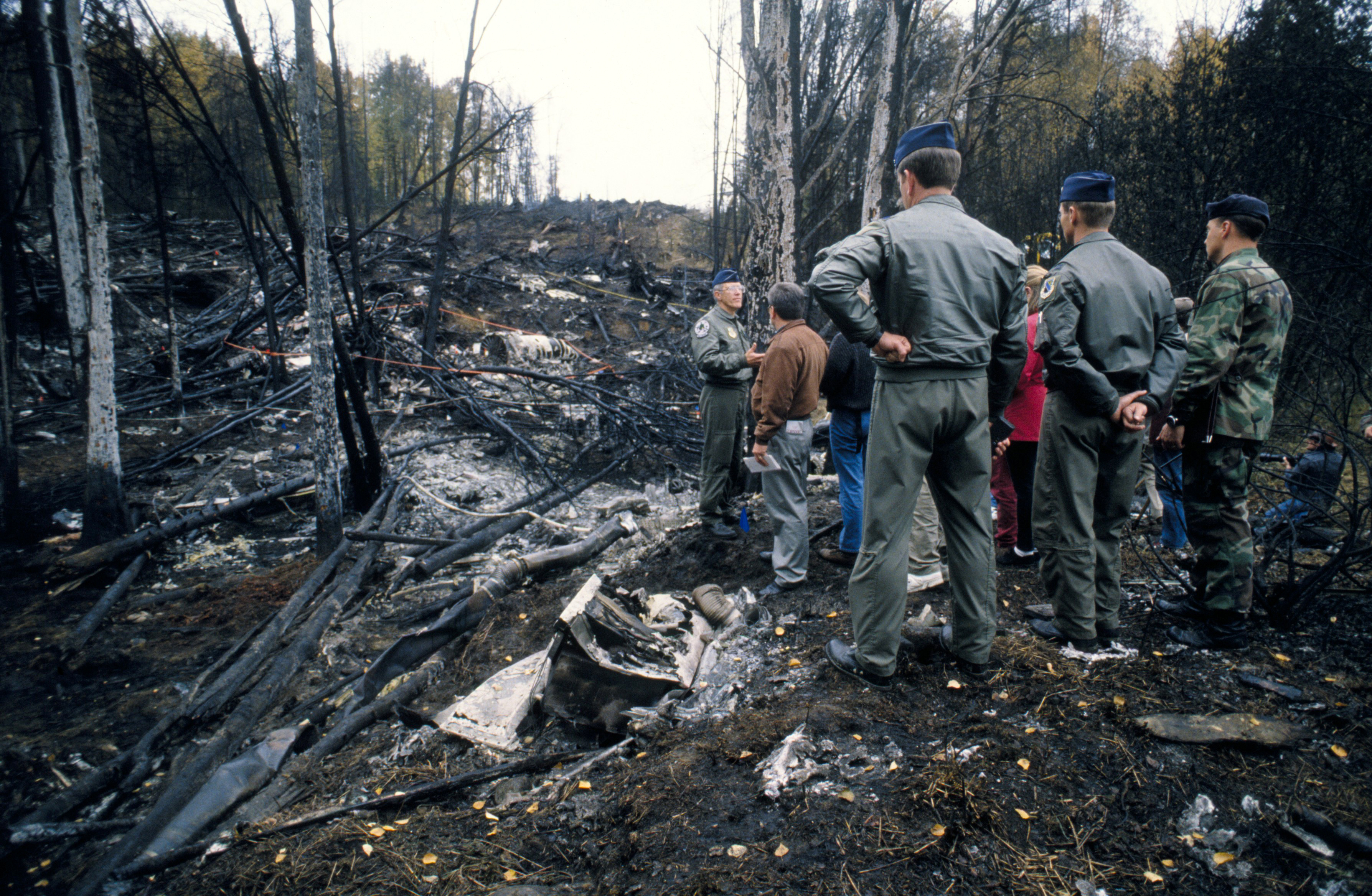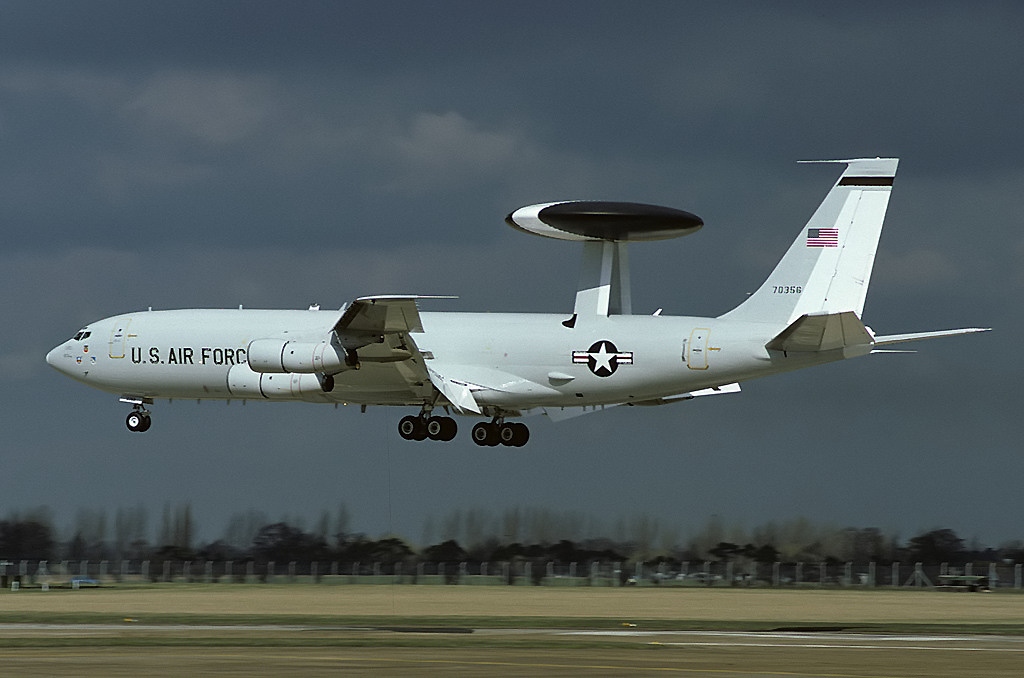1995 Alaska Boeing E-3 Sentry accident on:
[Wikipedia]
[Google]
[Amazon]
The Alaska Boeing E-3 Sentry accident was the September 22, 1995 crash of a
 The Sentry was being operated by the
The Sentry was being operated by the
 The
The
Yukla 27 website
Airborne Early Warning Association website
United States Air Force
The United States Air Force (USAF) is the air service branch of the United States Armed Forces, and is one of the eight uniformed services of the United States. Originally created on 1 August 1907, as a part of the United States Army Signal ...
Boeing E-3 Sentry
The Boeing E-3 Sentry is an American airborne early warning and control (AEW&C) aircraft developed by Boeing. E-3s are commonly known as AWACS (Airborne Warning and Control System). Derived from the Boeing 707 airliner, it provides all-wea ...
airborne early warning aircraft with the loss of all 24 crewmembers on board. The aircraft, serial number
A serial number is a unique identifier assigned incrementally or sequentially to an item, to ''uniquely'' identify it.
Serial numbers need not be strictly numerical. They may contain letters and other typographical symbols, or may consist enti ...
''77-0354'' with callsign
In broadcasting and radio communications, a call sign (also known as a call name or call letters—and historically as a call signal—or abbreviated as a call) is a unique identifier for a transmitter station. A call sign can be formally assigne ...
''Yukla 27,'' hit birds on departure from Elmendorf Air Force Base
Elmendorf Air Force Base is a United States Air Force (USAF) facility in Anchorage, Alaska. Originally known as Elmendorf Field, it became Elmendorf Air Force Base after World War II.
It is the home of the Headquarters, Alaskan Air Command (AL ...
in Alaska
Alaska ( ; russian: Аляска, Alyaska; ale, Alax̂sxax̂; ; ems, Alas'kaaq; Yup'ik: ''Alaskaq''; tli, Anáaski) is a state located in the Western United States on the northwest extremity of North America. A semi-exclave of the U.S., ...
, United States. With the loss of thrust from both of the left engines the aircraft crashed into a wooded area less than a mile from the end of the runway.
Accident
 The Sentry was being operated by the
The Sentry was being operated by the 962d Airborne Air Control Squadron
The 962nd Airborne Air Control Squadron, sometimes written as 962d Airborne Air Control Squadron, is part of the 3rd Wing at Joint Base Elmendorf-Richardson (JBER), Alaska. It operates the E-3G Sentry aircraft conducting airborne battle manageme ...
and was scheduled for a training sortie with the callsign ''Yukla 27''. The aircraft was to depart from runway 06 and was waiting while a C-130 Hercules
The Lockheed C-130 Hercules is an American four-engine turboprop military transport aircraft designed and built by Lockheed Corporation, Lockheed (now Lockheed Martin). Capable of using unprepared runways for takeoffs and landings, the C-130 ...
transport aircraft took off ahead of it. With its crew unaware that the Hercules had disturbed a flock of Canada geese
The Canada goose (''Branta canadensis''), or Canadian goose, is a large wild goose with a black head and neck, white cheeks, white under its chin, and a brown body. It is native to the arctic and temperate regions of North America, and it is o ...
, the Sentry lined up and started its departure roll. As the E-3 rotated it ingested multiple birds into its number 1 and 2 engines
An engine or motor is a machine designed to convert one or more forms of energy into mechanical energy.
Available energy sources include potential energy (e.g. energy of the Earth's gravitational field as exploited in hydroelectric power ...
. The crew started to dump fuel and initiated a turn to the left to return to the airfield, but with a full fuel load and having lost two engines on the same wing, it was unable to maintain altitude. After the aircraft reached 250 feet it descended and crashed into a hilly, wooded area, and exploded.
Investigation
The investigation concluded that the probable cause was the ingestion of Canada geese into the number 1 and 2 engines. Other factors included the insufficient efforts of the air base to deter the birds, and the failure of the air traffic control tower to report to both the Sentry and the airfield management that birds were present on the airfield. The sequence of events during impact was also determined. The aircraft struck the ground nose first and slid to the top of a hill, where theempennage
The empennage ( or ), also known as the tail or tail assembly, is a structure at the rear of an aircraft that provides stability during flight, in a way similar to the feathers on an arrow.Crane, Dale: ''Dictionary of Aeronautical Terms, third ed ...
(tail section) broke off. "As the ircraftcleared the second hill, it rolled over. The fuselage
The fuselage (; from the French ''fuselé'' "spindle-shaped") is an aircraft's main body section. It holds crew, passengers, or cargo. In single-engine aircraft, it will usually contain an engine as well, although in some amphibious aircraft t ...
broke up as the ircraftrolled. The outboard right wing impacted on the left side of the wreckage, the right-hand wing broke off and the rotodome section impacted on its back, breaking up the rest of the aircraft."
Investigators reviewed the flight and wreckage path of the accident aircraft. "The ircraftlifted off and flew approximately .28 kilometers (0.8 mile)before contacting trees," the report said. "The ircraftthen flew approximately .72 kilometers (0.45 mile)before making contact with the ground and crashing in a fireball."
Aircraft
 The
The Boeing E-3 Sentry
The Boeing E-3 Sentry is an American airborne early warning and control (AEW&C) aircraft developed by Boeing. E-3s are commonly known as AWACS (Airborne Warning and Control System). Derived from the Boeing 707 airliner, it provides all-wea ...
serial number
A serial number is a unique identifier assigned incrementally or sequentially to an item, to ''uniquely'' identify it.
Serial numbers need not be strictly numerical. They may contain letters and other typographical symbols, or may consist enti ...
''77-0354'' was built as an E-3A variant with the Boeing construction number 21554 and line number 933. It first flew on July 5, 1978 and was delivered to the United States Air Force on January 19, 1979. It was later modified by Boeing to E-3B standard.Pither 1998, pp. 403-404
This aircraft was used on the first day of the Desert Storm
The Gulf War was a 1990–1991 armed campaign waged by a 35-country military coalition in response to the Iraqi invasion of Kuwait. Spearheaded by the United States, the coalition's efforts against Iraq were carried out in two key phases: ...
air war, with its crew controlling the intercept and shootdown of four Iraqi fighter aircraft in far western Iraq.
The aircraft was also involved in the April 14, 1994 Black Hawk shootdown incident in Iraq, during which its crew were controlling two F-15 Eagle
The McDonnell Douglas F-15 Eagle is an American twin-engine, all-weather tactical fighter aircraft designed by McDonnell Douglas (now part of Boeing). Following reviews of proposals, the United States Air Force selected McDonnell Douglas's ...
fighter aircraft that shot down a pair of US Army UH-60 Blackhawk
The Sikorsky UH-60 Black Hawk is a four-blade, twin-engine, medium-lift utility military helicopter manufactured by Sikorsky Aircraft. Sikorsky submitted the S-70 design for the United States Army's Utility Tactical Transport Aircraft System ( ...
helicopters, killing 26 military and civilian personnel.
See also
* 2010 Alaska USAF C-17 crash, a 2010 accident that also took place at Elmendorf AFB, crashing a mere away from where the E-3 had crashed 15 years prior.External links
Yukla 27 website
Airborne Early Warning Association website
References
;Notes ;Sources * {{DEFAULTSORT:Alaska Boeing E-3 Sentry accident Accidents and incidents involving United States Air Force aircraft 1995 in Alaska Aviation accidents and incidents in 1995 Accidents and incidents involving the Boeing 707 Aviation accidents and incidents in Alaska Airliner accidents and incidents caused by bird strikes September 1995 events in the United States